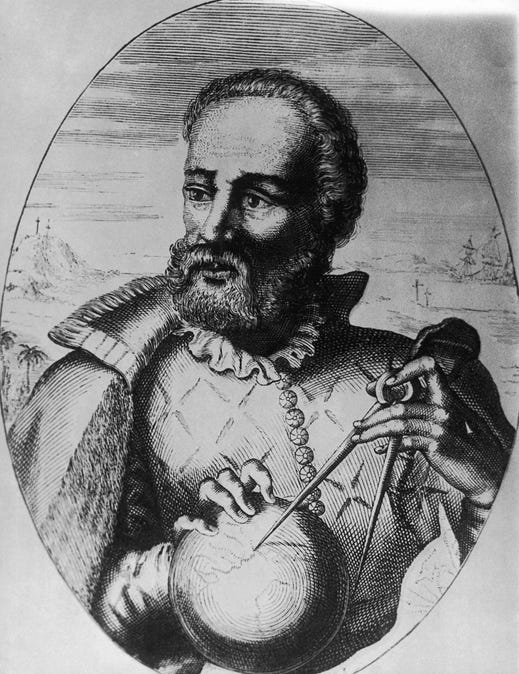“After the Wedding” by John Daniel from Common Ground. © Confluence Press, 1988.
ORIGINAL TEXT AND AUDIO - 2017
Today is the birthday of poet and playwright Laurence Binyon, born in Lancaster, England (1869). He was deeply affected by the First World War, and though he was too old to serve, he is best remembered for his poem For the Fallen, which is often recited on Remembrance Sunday in Britain, Canada, New Zealand, and Australia. He wrote it in 1914, sitting on the cliffs of Cornwall and looking out to the sea.
An excerpt from For the Fallen:
They went with songs to the battle, they were young,
Straight of limb, true of eye, steady and aglow.
They were staunch to the end against odds uncounted;
They fell with their faces to the foe.
They shall grow not old, as we that are left grow old:
Age shall not weary them, nor the years condemn.
At the going down of the sun and in the morning
We will remember them.
It was on this date in 1846 that the United States Congress passed legislation creating the Smithsonian Institution.
James Smithson was an English scientist. He was also the illegitimate son of a nobleman and a widow who was related to the royal family. He was born in secret in Paris, and though he inherited a lot of money from his mother, his illegitimacy kept him from any of the social or career advantages that his family connections might have given him. He once wrote, "On my father's side I am a Northumberland, on my mother's I am related to kings, but this avails me not." He never married, and spent his life traveling and getting to know some of the greatest scientific minds of Europe. He believed scientists should be "citizens of the world," and wrote, "It is in knowledge that man has found his greatness and his happiness." Smithson published more than two dozen papers on a wide variety of subjects.
Shortly before his death in 1829, he bequeathed his estate to his nephew. But if the nephew died childless, Smithson wrote, then the money was to go to the United States for the foundation of an institution for "the increase and diffusion of knowledge." The nephew died without any heirs in 1835.
The bequest sparked a debate in Washington between the Federalists and the supporters of states' rights. The states' rights people argued that the Constitution didn't make any provisions for a national institution. But the Federalists won out, and in 1838, the entire estate, worth more than half a million dollars, was transferred to the United States Mint. The debate didn't end with the Federalists' victory, though. For nearly a decade, people argued about what he meant by the "increase and diffusion of knowledge." Did he mean a university? If so, what kind? Did he mean an observatory, a research institute, a publishing house, a national library, or a museum?
In the end, it became all of those things, with the exception of the university. The Smithsonian complex now includes museums of natural history, American history, fine and decorative arts, and air and space technology: 19 museums and galleries in all, including the National Zoo.
It was on this date in 1519 that the explorer Ferdinand Magellan set off to sail around the world. Although he was Portuguese, Magellan had sworn allegiance to Spain, and he began the journey with a fleet of five ships and 270 men to see if he could accomplish what Columbus had failed to: find a navigable route to Asia that didn't involve going around Africa. They set sail from Seville, heading west. After crossing the Atlantic, surviving a mutiny, and losing one ship, Magellan reached Brazil and turned south, following the coast until he came to a deep-water strait that separated the rest of South America from Tierra del Fuego. Magellan entered the strait on November 1, 1520; that is All Saints' Day, so he christened it the Strait of All Saints. Later, the Spanish king changed its name to the Strait of Magellan. After 373 miles in the strait, Magellan became the first European to enter the Pacific Ocean from the east, and he's the one who named it "Pacific," because it was much calmer than the Atlantic.
Unfortunately for Magellan, he never completed the voyage. The fleet stopped off in what are now the Philippine Islands, where Magellan befriended a local chief and offered to help him in his war with the natives on a neighboring island. He was killed in battle in April 1521, and the remaining fleet continued on without him. They arrived back in Seville — down to one ship and 18 men — on September 8, 1522.
Be well, do good work, and keep in touch.®
If you like these newsletters, you can support this effort by:
*Clicking the Subscribe button (though this is free, you can make a paid contribution)
Stop by our Store and select what works for you - CLICK HERE
Send a check to: Prairie Home Productions, P.O. Box 2090, Minneapolis, MN 55402





Terrific post! Learned a lot as always